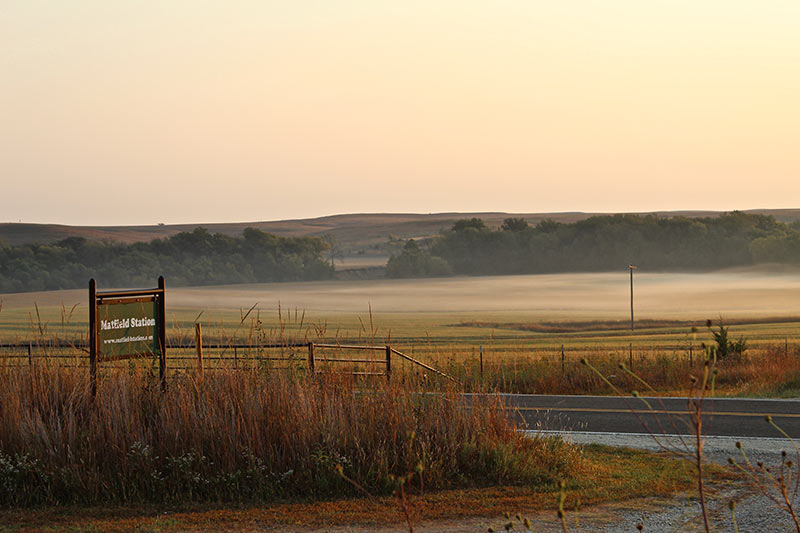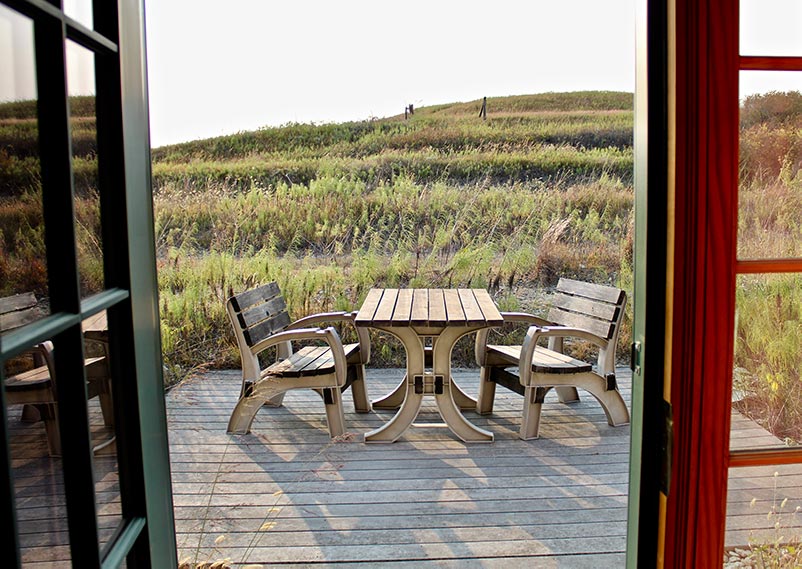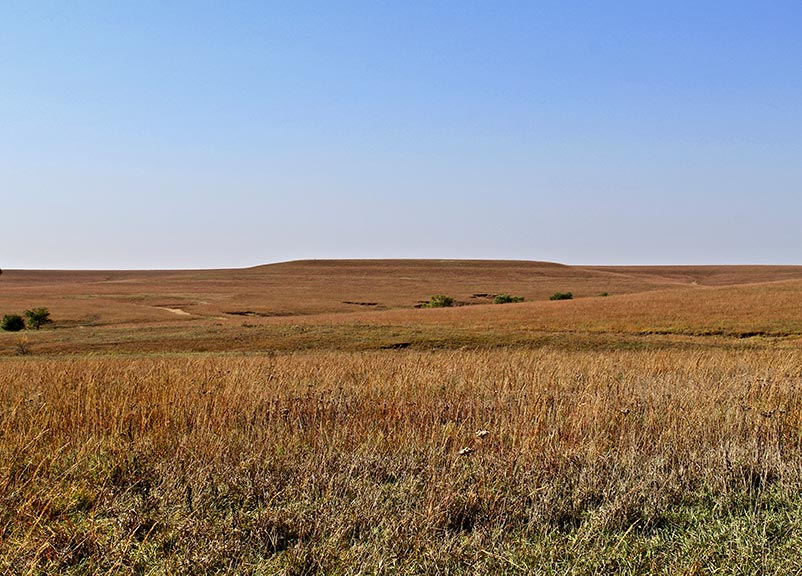The landscape may stay the same, but “home” can look totally different at different times in our lives. Shawna Bethell came back to Kansas and went to see the last remaining patches of tallgrass prairie — it was a homecoming she didn’t expect.
Can you remember a moment that changed you? Perhaps only a sliver of a moment, yet one that remained so subtly that it’s years later before you finally say, “Yes, that was when I knew…”
It happened to me in the ’90s. I was young then and driving a sleek, black sports car along an undulating back road commuting through the heart of the Kansas Flint Hills to reach my graduate class on time. It was understood that speed was of no consequence on this empty byway as traffic was nearly non-existent, and if you did encounter the patrol, the highway was so narrow they would have no place to turn around. The only reprimand I ever did receive was a brief flash of red lights from an oncoming officer, who was likely traveling as fast as I was. So I regularly topped and descended those hills so sharply that my stomach felt the effects. Windows down, music up, I watched the land pass in a current of endlessness.
Then one morning, as the horizon was perfectly bisected between heavy, slate-colored clouds and brilliant green hills, a light rain misted the air and the isolated heart of the land seemed more removed than usual. I slowed and my music quieted, and I drove along, taking in more of the landscape than I usually did. Up ahead, along the fence line that paralleled the road, a small, yellow dot appeared, and as I got closer, a solitary man on a horse materialized from the gray — his characteristic broad-brimmed hat pulled low on his brow, his yellow rain slicker the beacon I had seen from the distance. By the time I reached him, he was turning northward away from the road, disappearing again into the mist. But a wistfulness had already settled in me. The stranger and his horse, the land and the elements: in my mind their hushed solitude embodied something I could not yet name, only feel.
I drove on. I completed my studies. I graduated, and I laid plans. “Go west, young woman!” I heeded the call. Cattle and corn, God and country. The presumptive rhetoric that fed it all. I wanted none of it. I left my home state without a backward glance, glad to finally be gone. So it was with irony that 20 years later, bowing under the weight of caregiving and at a time I needed solace, I looked to Kansas.
I would not say distance had made the heart fonder, but I would say learning about the ecological systems of my home state had made me aware that in all the years I had driven the Flint Hills, I had never experienced the tallgrass prairie that gave the land its mystique. It is true that I had seen the hillscape in each of her seasonal guises: the dead-brown of winter, the eerie serpentine fires of spring, the rebirth of those endless waves of emerald green each summer. And every fall I had watched the green turn to bronze in the dying light of the year. But I had never walked the Tallgrass, never been among the swaying and majestic big bluestem when it reached its zenith of six to eight feet. The desire to do so — and the quietude it would offer — lured me home.

It was early October when I pulled into Matfield Station, a renovated railroad bunkhouse in the middle of nowhere yet just south of the Tallgrass Prairie National Preserve. The station is a narrow, long building that had housed Mexican families in the early 1920s when they came to work for the Atchison Topeka & Santa Fe Railroad, but is today a three-unit Airbnb that outwardly appears blandly functional and inside is brightly painted and comfortably outfitted. Each tiny unit houses the needed kitchen, bath, bed, and writing desk. French doors open to the west.
I left unpacking for later, stepped through the French doors, and was quickly reminded that this had been a railway bunk. About 30 feet from the doors, a berm sloped upward and just hid the tracks that carried railcars north to south and back again every few hours. I heard the whistle and turned as a bright orange and black engine of the Burlington Northern & Santa Fe barreled past shaking the ground on which I stood. It was exhilarating! By 3 a.m. I was less enchanted, yet — sleepless — I was still called into the night where the reverberation rumbled through the earth and into my body. When silence settled again, I looked up. Above me the sweep of the Milky Way illuminated the deep, eternal indigo sky. Orion’s Belt peeked through the limbs of the reaching old cottonwood that towered over the small, squat building, and more stars than I had ever seen lit the world to the far horizons.
For the next few days I walked the mown trails around Matfield Station, and I recognized immediately that the gentle roll of hills you see from a car window is deceiving. Up close, the rises are steep and rocky, and it is this unwelcoming terrain that saved the Flint Hills from being plowed and planted like the rest of the state. Formed predominantly by limestone, the hill country eroded through centuries of flood and glaciation. As the limestone eroded, the harder, sharper fragments of flint accumulated at the surface. What was the bane of the plow, however, was the perfect ecosystem for prairie grasses and forbs, and as I walked the hills, I trailed my hand through the seed heads and swaying stalks that bowed in the wind. Indian grass, little bluestem, and the grand-majestic big bluestem. They were all there, along with so many other grasses and wildflowers I would never distinguish or name. As I rested atop a hill watching their endless waves, I now understood that it was their burgundy and gold stalks that cast the copper-pink hue over the autumnal land and caused the hills to veritably glow crimson when their colors were accentuated with each rise and fall of the sun.

I watched a red-tail hawk hunting from the currents and recalled the morning’s news report describing the drought that threatened the state. I remembered, too, reading that big bluestem needed more moisture than other grasses to reach its full height, and it came to me that the experience I had been planning for might not happen. But I pushed away my fears and resolved instead to look forward to my trip to the national preserve, where I would walk among a forest of grasses tall enough to brush my shoulders as I passed.
Across the Flint Hills and throughout Kansas, the tallgrass prairie was the original ecosystem. It fed the bison, which fed the wolves and the indigenous Kanza people. The real secret of the prairie, however, the source of its true mystique, was the mass of complex root systems that spread for miles and reached several feet into the earth searching for water and nourishment to sustain itself. It was this system’s regeneration of the soil that had made the land so coveted by European settlers that they ravaged it for their own crops, leaving the original prairie a mere percentage of the millions of acres that once swathed the North American continent.
Matfield Station was providing the solitude I needed, but I was on schedule to connect with friends in days to come, and it was time to start the next leg of travel. My walk among some of the last remaining tallgrass in the world was planned for the next day. I looked forward to hearing its rustle in what I had come to remember as the ever-present and relentless south wind.
My final morning at the bunkhouse, I took my cup and journal to the deck. Beyond the tracks, the glow of the hills abutted the dark western sky, and Venus hung bright as the last star to fade against the eastern rising sun. The dew was heavy and the air cold and damp. The sweet, earthy scent of grass carried lightly on the breeze. You can’t smell that sweetness in the arid heat of day, but morning…morning was fresh and fragrant. The light, clear song of a warbler cut the air.
By 10 a.m., I pulled into the parking lot of the Tallgrass Prairie National Preserve. It was already hot when I stuffed the recommended gallon of water, cell phone, map, and floppy hat into my pack and lifted it onto my shoulders. It was heavy, but I liked the weight. I stopped briefly at the visitor center for any warnings or alerts that hikers needed to be aware of and was reminded that the bison were free-roaming—visitors were advised to remain at least 100 yards from the herds. Then I started walking into the hills.

From my experiences at Matfield, I knew the deception of the trail before me. I kept my pace slow and steady, watching both the ground for snakes and lizards and the landscape for larger beasts. It would be a few miles in, I calculated, before I encountered the Tallgrass. I wanted to keep my energy sustained so I could spend the time I had planned for. The wind that had only been a breeze that morning now played at my hair, tugging at the clip that held the long strands from my face. My loose cotton blouse billowed and whipped against my body, and from my memory came the chorus of a song by old-school rock band Kansas. People of the South Wind. People of the Southern Wind. I had never liked the band, never liked the song. But the words played on repeat in my mind as that wind pushed hard at me while I climbed.
For those who did not spend their elementary years coloring photos of buffalo and sunflowers every January 29 (Kansas Day), I will share with you now that the American bison — the largest mammal in the lower 48 — is the Kansas state mammal. This is sadly ironic as the bison was exterminated in Kansas by 1879, 18 years after its ‘proud homeland’ became a state. These intentional measures were taken in a concentrated effort to get rid of the “south wind” people, the Kanza, whose name the state ultimately carried into history. This legacy, of course, was not clear to me as a child brandishing my yellow and brown Crayolas, but it was clear as I crested that first rise, as an adult who was re-learning the past, and saw a herd of bison scattered across the prairie in front of me.
From where I stood, I could see a few other tourists making their way up the next rise, cautiously trying to remember what 100 yards looked like from their years watching high school football. But even from where I stood, I could easily tell that the white gravel path that was the first leg into the preserve was blocked by the enormous, horned and shaggily furred beasts. Even from there, I knew my hope to walk the Tallgrass had ended. The bison grazed and rolled in the dusty, wildflower-dotted earth. Cows and calves roamed about, while bulls stood ground, unconcerned but equally unmistakably aware of us. At a distance I watched as the few hikers in front of me stepped as close as they dared and snapped a few photos before turning and heading back past me and toward the visitor center. A lone figure stood on the next rise, lower than where I now stood, and watched the scene before her.
I started forward, down the draw and climbed the next rise, feeling my heart beat as a scrawny human’s should when encountering such power. I walked slightly beyond the woman who had been watching the herd. Her hair was silver and her back slightly curved. We stood together in the wind, watching the past. I raised my camera and took several photos I knew would never come out. I was too far away and my lens too powerless, but I tried, wanting so badly to hold this moment. The woman and I quietly spoke our awe to one another and she lamented that she had forgotten her binoculars. I dug through my pack and handed mine over, then sat in the dirt beside my pack and waited. We stayed like that, I don’t know how long, pummeled by the wind and heat, each in our silence. When she handed back my glasses, I packed them away before bidding her a good rest of her journey. She wanted to stay alone with the bison for a while, and I understood.
I also understood that the disappointment I should have felt was not there, nor would it be. If only for a day, the bison were reclaiming their hills, their prairie, their land. I was content with that.
I turned and headed back down the draw and re-crossed the rise where I had first witnessed the bison. As I walked, I considered my home state’s deeper history — the legacy that is being restored in places like the preserve. I made my way back to the truck and tossed in my pack. I rolled down the windows, turned up my music and pulled from the lot. But instead of flying down that long and lonely highway, I drove without hurry, accepting what was offered until I could try again next year.
Top photo by Mobilus in Mobili (CC-BY-SA). Other photos courtesy of Shawna Bethell.
